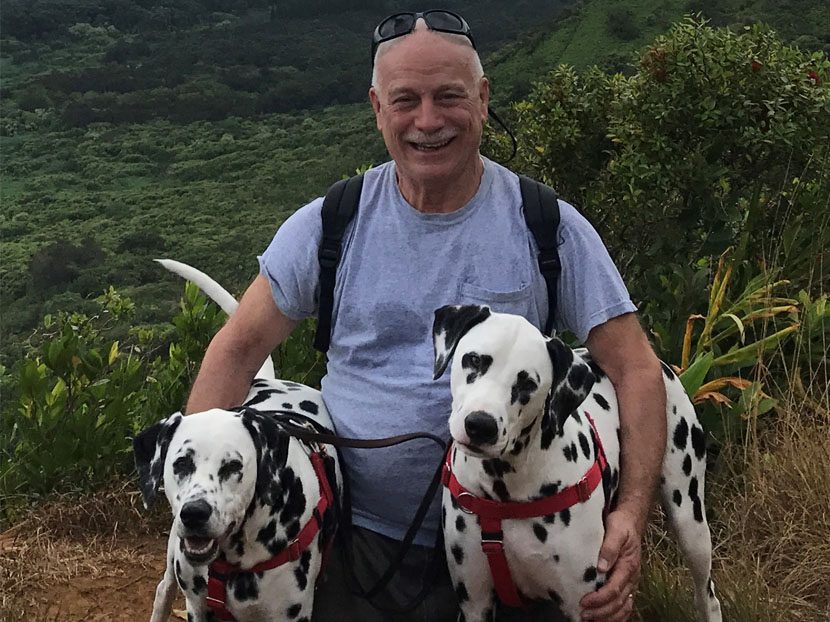Best Friends
How Dalmatians became the definitive firehouse dogs.

Dalmatians are not for everyone. They are strong, high-energy animals that need exercise and demand a lot of attention. If they do not get it, they will eat your sofa. It is why my Dalmatians take me for a long walk (or drag) twice a day. Our replacement sectional is very nice and I intend to keep it that way.
While walking our two Dalmatians each day, passersby often make comments or ask me questions such as, “Where are the other 99?”
Another question I often get is, “How did Dalmatians become the definitive firehouse dogs?” To answer this, we need to look at the history of the breed.
From my research on the Internet, it seems the prevailing opinion is Dalmatians got their name from Dalmatia, a region of Croatia consisting of a strip of coastal land and several islands along the Adriatic Sea.
The Croatian Kennel Club notes that a spotted dog appears in an altar painting Madonna with Jesus and Angels in a church on the island of Losinj in Croatia, dating back to the early 1600s. It is reported that their ancestors were used as “dogs of war” guarding the borders of Dalmatia.
The breed eventually made it to England, where it was refined. Thomas Beswick wrote in his 1790 book, A General History of Quadrupeds, “[The Dalmatian] is common in this country at present, and frequently kept in genteel houses, as an elegant attendant on a carriage.”
In England, Dalmatians had found their true vocation as carriage or coach dogs because they get along with horses very well. Dalmatians had a very calming effect on horses, could endure long runs and were easily trained to run in front of or alongside horse-drawn carriages.
The presence of a pair (or more) of Dalmatians accompanying the carriage came to be a status symbol among socially conscious Englishmen.
Friends to Firehouses
Using Dalmatians as carriage dogs eventually carried over to the Americas, where they were brought into firehouses in the late 1800s to early 1900s to serve as carriage dogs for the horse-drawn fire wagons, notes Livescience.com article “Why Are Dalmatians the Official Firehouse Dogs?”
According to the article, “When a fire alarm sounded, the Dalmatians would run out of the firehouse, barking to let bystanders know that they should get out of the way because the firefighters' wagon would soon come roaring by. Once the wagon was out on the street, the Dalmatians would run beside it.”
The article goes one to state, “The brave, loyal dogs also served an important purpose once the wagon approached a fire. Horses are afraid of fire and the Dalmatians' presence could distract and comfort the horses as they pulled the wagon closer to a blaze. The Dalmatians also stood guard near the wagon to ensure that no one stole the firefighter's belongings, equipment or horses.”
As with many dogs, Dalmatians are fiercely loyal to their pack; while en route to the fire, they would defend the horses from any attempted attacks by other dogs or animals.
It was only natural after the days of horse-drawn fire apparatus ended that Dalmatians remained as firehouse mascots. Tradition played a part, of course, but Dalmatians also make good watchdogs and are reported to be excellent ratters. But the most important reason is Dalmatians are wonderful, loving friends.
Horse-drawn fire trucks were the only carriages to adopt Dalmatians. Do you remember the recent Superbowl commercial with a windblown Dalmatian aboard the Anheuser-Busch carriage?
Budweiser introduced the Dalmatian to its traditional Clydesdale procession in 1950, according to Popsugar.com’s “Story Behind the Scenes: Clydesdales and Dalmatians.”
The article states, “These companions to the hitch had a vital role during the early days of brewing; they were trained to protect the horses and guard the wagons while the drivers went in to make their deliveries,” the article explains.
The article continues, “Nowadays, they typically ride shotgun, perched atop the wagon next to the driver anytime the Budweiser Clydesdales make a public appearance. … [T]he dogs and horses have a strong bond as they are introduced (and obedience trained) since puppyhood, and often the pooches sleep in the stables at night.”
Our Dalmatians
When I was with Engine 291 of the Silver Hill Volunteer Fire Department in Prince Georges County, Md., our Dalmatian was Tick Dog, the daughter of Lady, the prior mascot to Company 29. Tick was usually the first to the apparatus when the alarm sounded. One day, a firefighter who did not particularly like dogs would not let her get on the engine. She was not very happy and as I ran up to jump on the tailboard, something took a bite out of my rear.
Tick and I got along well. When she was happy to see you, she would tuck in her lips and show some of her teeth in what clearly was a smile. Most of our other Dalmatians are also able to smile in this way, something I have not seen in other breeds. A dedicated and fierce firefighter, Tick sadly died in the line of duty in 1982.
My first Dalmatian, Domino, came to me in a box of young pups someone had brought up to the fire station one day in 1977. Not able to resist, I picked one and brought him home. Domino loved to run free in the local wooded areas.
My wife and I brought Spanner home in 1987, shortly before our son was born. Spanner had liver-colored spots, present in about 10 percent of Dalmatians. My brother and his wife were visiting us in Hawaii and we decided to go out after our Thanksgiving feast. When we got home, our 20-pound turkey, which we had left on the kitchen counter, was missing. It was gone; no leftovers for us! Spanner did not seem any worse for wear.
Tiller joined us in 1994 to keep Spanner company. She was our roly-poly pup, never one to refuse a treat. She was also the most loving of all our dogs.
Halligan came to us in 1998, our biggest Dalmatian by far. He had few spots, giving him the look of an albino. In late 2015, Halligan was well on in years. While at a meeting in Milwaukee, Linda called and frantically told me she could not get Halligan to awaken. After she hung up, thinking we had lost him, I began making arrangements to come home a day early. A few minutes later she called back and said he was awake, and everything seemed OK.
I got home on a Friday morning and took Halligan and Kaylee out for a walk. Though he walked very slowly, he was in very good spirits, enjoying his walk immensely. That night we found him on his dog bed and this time he could not be roused. We all sat with him while he quietly passed away. There is no doubt in my mind that he had waited for me to get back home so we could share one more walk.
We obtained Kaylee from a breeder in Sydney in 2010. Our Aussie lass is our most fearless. Right out of the travel kennel, after bringing her home from the airport, she ran towards the much bigger Halligan and jumped up at his snout to give him a welcome kiss.
One day our daughter came running into the house exclaiming, “Kaylee just fell out of the tree!”
She had managed to walk up the low, sloping limbs of the mango tree in the front yard and tried to lunge at a bird. Fortunately, puppies are made from rubber and the 10-ft. fall to the ground did not result in damage.
Mackie is our most recent Dalmatian and another Aussie. Still a pup at four years old, he has been a great friend to Kaylee. Linda has taught him many cool tricks — Mackie is the only dog I know who can moonwalk! He always appears to be looking at you in a very thoughtful way.
I firmly believe dogs teach us to be better humans and, as a breed, Dalmatians are among the best friends anyone can have.





